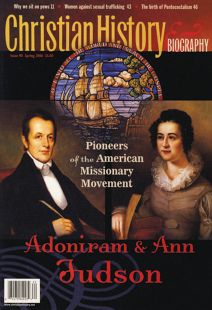Seats of learning
“Stand if you are able,” the pastor says on Sunday morning as we sing a hymn. “Please be seated,” he or she says, and we return to our normal posture for the sermon, Scripture reading, or pastoral prayer. But before the late Middle Ages, most Christians would have found our extensive sitting in church extremely odd. Where did pews come from, and why do we spend so much time in them?
Early Christians worshipped in private homes, and we know little of the architecture of those house churches. Once Christians could build public spaces for worship, they adapted the design of Roman law courts, where the judge was seated and others stood before him. The front of the church (the apse, or chancel) had seats for the bishop and assisting ministers, while the people's part of the building (the nave) was larger and unencumbered by seating, except at low ledges around the side for the elderly or infirm. People stood or knelt where the action was. If a procession took place, they simply moved out of the way.
In the Middle Ages, the action moved further away from the nave. Monastery chapels provided a long chancel with seats, where the monks faced each other, and a “high” or main altar at the far end of the chancel. Often there were multiple altars around the church with several Masses going on simultaneously. When churches adopted this arrangement, seats were provided in the chancel for clergy and wealthy laity. The rest of the congregation stood in the nave, often moving from altar to altar when the ringing of a bell warned them that each Mass had reached its climax with the elevation of the Host. In between, they said their own prayers or even engaged in secular conversation. In the 1400s, isolated benches were built to enable them to pray more comfortably, but much open space remained.
The Protestant Reformers wanted to reconnect the people with the action at the front of the church. They also wanted worship to serve a teaching function. So, for the first time, they asked the whole congregation to sit on pews and pay attention. Many found worshipping in this way very puzzling, as historian Robert Kingdon has written about Calvin's Geneva, “There were frequent cases heard by the Consistory in its early years of people called in and accused of babbling in church, even during a sermon. When pressed they would say in some distress that they were simply saying their prayers.” After being told to “shut up and listen,” Kingdon continues, the same people “would be called back in later sessions to find out what they were gaining from sermons … If they had trouble answering these questions they would be told to go to church more often, to listen to even more sermons.” The Catholic Counter-Reformation, with its renewed focus on preaching the Word and educating the laity, also found pews congenial to these aims, and pews were common in both Catholic and Protestant churches by 1600.
The experimentation of 1960s worship—fueled by the charismatic movement and by Vatican II—tried to get the congregation up and moving again, allowing flexible room in nave and chancel for drama, dance, processions, and movements of the Spirit. This represented a conscious return to early church models. In many non-Western churches, the congregation has never sat down. Eastern Orthodox worship (except in some modern churches that have introduced seats) has historically maintained the early and medieval practice of standing and combining personal devotions with attention to readings, music, and actions taking place at the front of the church. To recapture the noise, color, activity, and drama of pew-less worship, one could do worse than pay a visit to a nearby Orthodox congregation.
By Jennifer Woodruff Tait
[Christian History originally published this article in Christian History Issue #90 in 2006]
Jennifer Woodruff Tait is a historian living in Indiana.Next articles
Let Freedom Ring
The young American republic was ready to break new frontiers-at home and abroad. It's no wonder missionary pioneers Adoniram and Ann Judson were the "American Idols" of their day.
Ruth A. TuckerThe Man Who Gave the Bible to the Burmese
As a preacher, translator, prisoner, Husband, and homeland hero, Adoniram Judson demonstrated his conviction that a missionary is a missionary for life.
Richard V. PierardThe Mother of Modern Missions
By bravely going where no American wife had gone before, Ann Hasseltine Judson inspired generations of women to become missionaries.
Dana L. RobertMore than rubies
Widowed twice, Adoniram Judson was blessed with not one but three extraordinary wives. Though Ann was the first and most famous, Sarah and Emily made significant contributions of their own.
Rosalie BeckSupport us
Christian History Institute (CHI) is a non-profit Pennsylvania corporation founded in 1982. Your donations support the continuation of this ministry
Donate



